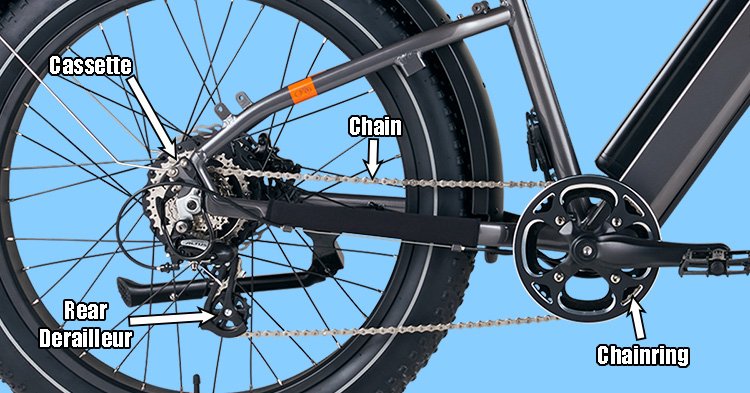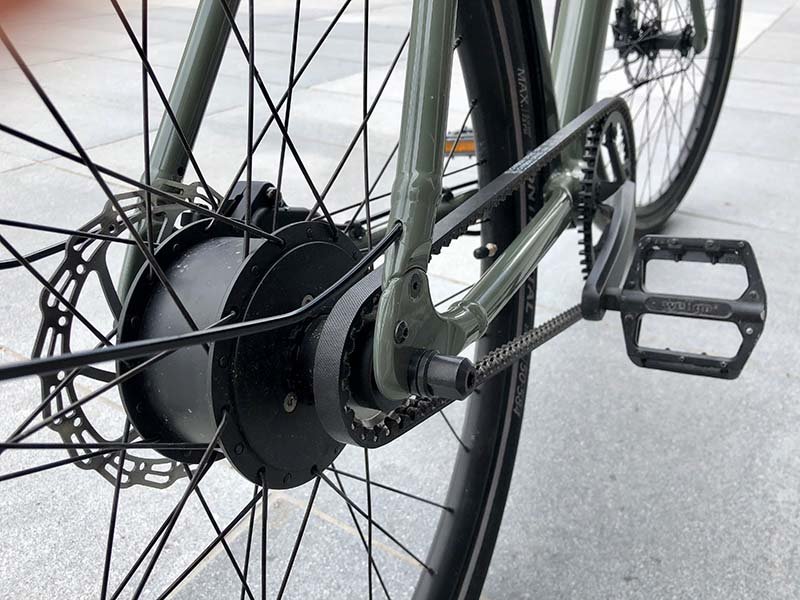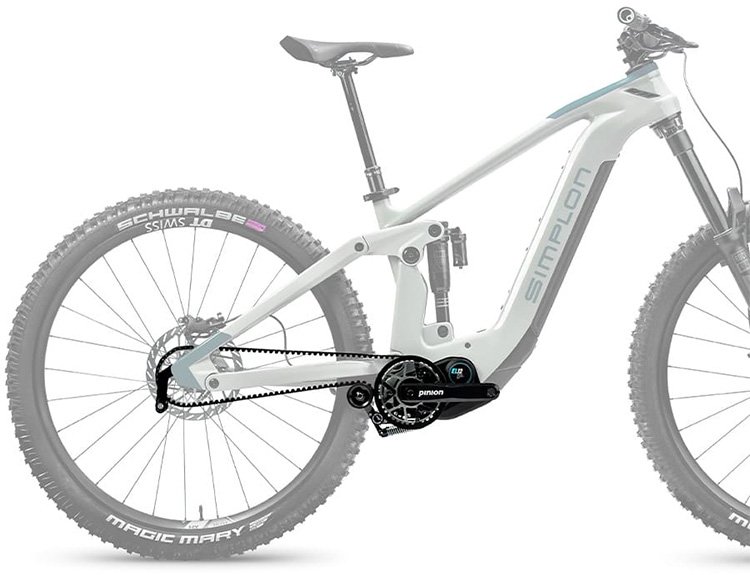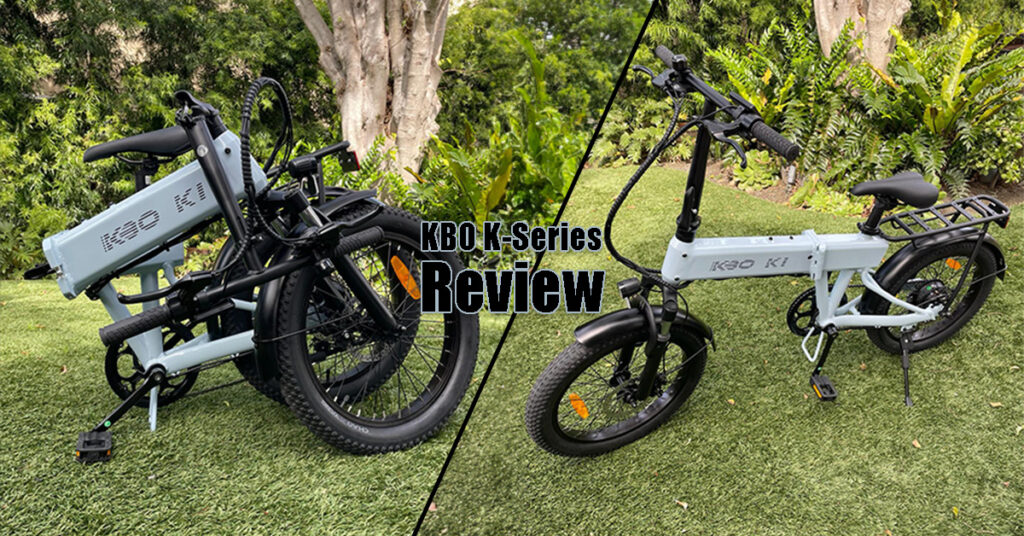Beyond the motor and battery, there’s another crucial component on our ebikes: the gearing system.
I have put together a comprehensive overview of different e-bike gearing systems, how they work, and how to maintain them.
Read along to find out more!
Overview of Electric Bike Gears
Most electric bikes have a gear system, allowing riders to adjust to various terrains and optimize their riding experience.
These gears function similarly to those on traditional bicycles but are designed to complement the electric motor’s power.
However, it’s worth noting that there are also single-speed e-bikes available, which offer a simpler riding experience without the need for shifting.
The question of whether you need gears on your electric bike largely depends on your riding preferences and the terrains you frequent.
Gears offer versatility. With them, you can easily tackle a variety of landscapes, from steep hills to flat roads, ensuring optimal power and efficiency from your e-bike’s motor. They allow you to fine-tune your pedaling effort, making rides smoother and more enjoyable.
On the other hand, single-speed e-bikes offer simplicity. Without gears to worry about, your rides are straightforward and maintenance is often reduced. However, they might not be the best choice for areas with varied terrains, as they don’t provide the flexibility to adjust your pedaling resistance.
Optimal Number of Gears On Your E-Bike
Determining the ideal number of gears for your electric bike isn’t a one-size-fits-all answer. The “right” number varies based on individual needs, riding habits, and the terrains you frequent.
While some riders might find a 3-speed gear system sufficient for city commutes, others might opt for a 7-speed or even 11-speed setup for more varied landscapes or performance-oriented rides.

Different Types of Gears On Ebikes
Electric bikes, much like their traditional counterparts, come with a range of gearing systems. These systems are designed to enhance the riding experience, offering flexibility, efficiency, and adaptability across various terrains and conditions.
Derailleur Gears
Derailleur gears are a staple in the world of cycling, and their presence in electric bikes is no exception.
Characterized by their external setup, derailleur systems utilize a combination of a rear mechanism, often referred to as the ‘derailleur’, and a series of sprockets known as the ‘cassette’.

The magic of this system lies in its ability to “derail” the chain from one sprocket to another, allowing for swift gear changes.
On e-bikes, this mechanism is enhanced to work seamlessly with the motor, ensuring smooth transitions even with the added power.
Typically, you’ll find that e-bikes might have a rear derailleur alone or, in some cases, an additional front one. This system’s adaptability and range make it a popular choice for many e-bike enthusiasts, from urban commuters to off-road adventurers.
Pros of Derailleur Gears
- Lightweight Design: Derailleur systems are generally lighter than other gear setups, contributing to an overall reduction in the e-bike’s weight, which can enhance maneuverability and ease of handling.
- Cost-Effective Maintenance: Being an external system, derailleurs are often easier and more affordable to repair or replace compared to internal gear hubs.
- Efficiency: Derailleurs are known for their efficiency, allowing for quick and precise gear changes, which can be especially beneficial when transitioning between terrains rapidly.
- Wide Gear Range: Offering a broad spectrum of gearing options, derailleurs can cater to various riding needs, from steep hill climbs to high-speed flat terrains.
- Adaptability: Modern derailleur systems are designed to work harmoniously with e-bike motors, ensuring that the added power from the motor doesn’t compromise the gear-shifting experience.
Cons of Derailleur Gears of E-Bikes
- Exposure to Elements: Being an external system, derailleurs are susceptible to dirt, grime, and weather conditions, which can affect their performance over time.
- Maintenance Frequency: Due to their exposure, they require regular cleaning and maintenance to ensure smooth operation and prevent wear and tear.
- Vulnerability to Damage: Positioned close to the ground, derailleurs can be prone to impacts, especially during off-road rides or if the bike tips over, potentially leading to misalignment or damage.
Hub Gears (Internal Gearing)
Hub gears, often referred to as internal gear hubs (IGH), present a contrasting approach to the external derailleur system.
Encased within the rear hub of the e-bike, this system operates in a more concealed manner, hiding its intricate mechanics from the naked eye.

Instead of “derailing” a chain across varying sprockets, hub gears utilize a set of internal cogs that shift positions, allowing for gear changes. The beauty of this system lies in its compactness and protection from external elements.
E-bikes equipped with hub gears offer riders a cleaner, low-maintenance gearing solution. While they might seem like a modern innovation, hub gears have a rich history, having served cyclists for over a century.
Pros of Hub Gears of Electric Bikes
- Protected Mechanism: Encased within the hub, these gears are shielded from dirt, water, and other external elements, ensuring consistent performance and reduced wear over time.
- Low Maintenance: The internal setup requires less frequent cleaning and adjustments, making it ideal for riders who prefer a hassle-free experience.
- Seamless Shifting: Hub gears allow for smooth transitions between gears, even when stationary. This feature is particularly beneficial for urban riders who often encounter stop-and-go situations.
- Compatibility with Belt Drives: Unlike derailleurs, hub gears can work in tandem with belt drives, offering a quieter and often longer-lasting alternative to traditional chain systems.
- Consistent Chain Position: With the chain remaining in a fixed position, there’s a reduced risk of it dropping off, ensuring a more reliable and uninterrupted ride.
Cons of Hub Gears of E-Bikes
- Added Weight: The internal components of hub gears often contribute to a heavier rear wheel, potentially affecting the bike’s balance and handling.
- Limited Gear Range: While advancements have been made, many hub gear systems still offer a narrower range of gears compared to some derailleur setups, which might limit versatility in varied terrains.
- Complex Repairs: If issues arise within the internal mechanism, repairs can be intricate and might require specialized expertise, making DIY fixes more challenging.
- Cost Implications: High-quality hub gear systems, especially those with a greater number of gears, can be more expensive than their derailleur counterparts, both in initial cost and potential repair fees.
- Wheel Removal Difficulty: For tasks like tire replacements or puncture repairs, removing a wheel equipped with a hub gear system can be more cumbersome than one with a derailleur.
Single-Speed Gearing: E-Bikes with No Gears
When discussing traditional gearing systems, we can’t overlook single-speed e-bikes, also known as e-bikes with no gearing system.
These e-bikes strip away the complexities of multiple gears, offering a straightforward and uncomplicated riding experience.

Single-speed e-bikes operate on a single gear ratio, meaning the relationship between the front chainring and the rear sprocket remains constant. This simplicity brings about several advantages:
- Low Maintenance: With fewer moving parts, there’s less that can go wrong. Riders won’t have to worry about gear adjustments, cable stretches, or the intricate cleaning required for multi-gear systems.
- Durability: The absence of derailleurs and other external components makes single-speed e-bikes less susceptible to damage from falls, impacts, or environmental factors.
- Efficiency in Flat Terrains: In urban settings or flat landscapes, a single-speed e-bike can offer a smooth and efficient ride without the need for constant gear shifting.
- Weight Savings: Without the added weight of gear systems, these e-bikes tend to be lighter, making them easier to handle and maneuver.
However, single-speed e-bikes might not be the best choice for everyone.
They can be challenging on hilly terrains, where multiple gears can provide the flexibility needed to tackle ascents and descents efficiently. Riders might find themselves exerting more effort on climbs or lacking speed on descents.
Advanced Electric Bike Gearing Systems
While we’ve delved into the more traditional gearing systems commonly found on e-bikes, the world of electric cycling is ever-evolving.
Innovations and advancements in technology have given rise to a new generation of sophisticated gearing mechanisms. Let’s explore these cutting-edge systems and understand what they bring to the table.
Continuously Variable Transmission (CVT)
Continuously Variable Transmission, commonly referred to as CVT, represents a significant leap in e-bike gearing technology.

Unlike traditional gear systems that offer a fixed number of gear ratios, CVT provides an almost infinite range of ratios.
This means that instead of shifting from one distinct gear to another, riders can seamlessly adjust the gear ratio to precisely match their riding conditions and desired pedal effort.
The core of a CVT system lies in its ability to change the effective size of its drive and driven pulleys. As the rider adjusts the gear ratio, these pulleys expand or contract, altering the effective diameter and thus the gear ratio.
The result is a smooth, uninterrupted transition through the gear range, eliminating the jolts and pauses typically experienced with conventional gear shifts.
Pros and Cons of CVT Gearing
Pros:
- Seamless Shifting: CVT allows for smooth and uninterrupted transitions across the gear range, eliminating the sudden jolts often experienced with traditional gear changes.
- Adaptable Riding: With an almost infinite range of gear ratios, riders can fine-tune their pedaling effort to match any terrain or riding condition precisely.
- Low Maintenance: CVT systems, being enclosed, are less exposed to external elements, reducing wear and tear and the need for frequent adjustments.
- Ease of Use: Riders don’t need to pre-plan gear changes or worry about being in the “wrong” gear. The system adjusts fluidly to the rider’s needs.
- Enhanced Efficiency: The ability to maintain an optimal pedaling cadence across various terrains can lead to a more efficient ride and better battery usage on e-bikes.
Cons:
- Weight: CVT systems can be heavier than traditional derailleur setups, potentially affecting the bike’s overall weight.
- Cost: Advanced technology often comes with a higher price tag, making CVT-equipped e-bikes more expensive than their traditional counterparts.
- Pedal Resistance: Some riders might feel a bit more pedal resistance with CVT systems compared to other gear setups.
- Battery Drain: While the efficiency of pedaling can be improved, the continuous adjustments in a CVT system might lead to faster battery consumption in certain conditions.
- Learning Curve: For those accustomed to traditional gearing systems, adapting to the nuances of a CVT might take some time and practice.
Electronic and Wireless Shifting
Moving away from the conventional cable-actuated gear changes, electronic shifting systems utilize motor-driven mechanisms to execute precise and rapid gear shifts at the push of a button.
The essence of electronic shifting lies in its precision. Each shift is executed with exact accuracy, ensuring that the chain aligns perfectly with the desired gear every time. This precision not only enhances the riding experience but also reduces wear and tear on the drivetrain components.
Wireless shifting takes this concept a step further by eliminating the need for physical cables. Instead, gear changes are communicated via wireless signals from the handlebar-mounted controls to the derailleur.
This results in a cleaner setup with fewer components susceptible to damage or wear, and it also allows for more flexible positioning of shift buttons.
Incorporating advanced sensors and algorithms, some of these systems can even auto-adjust or suggest optimal gear changes based on the terrain and riding conditions. It ensures that the rider is always in the best gear for maximum efficiency and comfort.
Bottom Bracket Gearing
Diving deeper into the realm of innovative e-bike gearing systems, we encounter the intriguing concept of bottom bracket gearing.

Unlike traditional setups where the gears are located at the rear wheel or within the hub, bottom bracket gearing places the entire gear mechanism around the pedal axle, right at the heart of the bike.
This centralized positioning offers a unique advantage: it distributes the weight of the gear system evenly across the bike, potentially improving balance and handling.
Additionally, since the motor power doesn’t pass through these gears, there’s a significant reduction in wear and tear, ensuring a longer lifespan for the components.
The bottom bracket gearing seamlessly integrates with the rear hub motors. This synergy allows for a smooth transfer of power from the motor through the gears, optimizing the bike’s performance.
Moreover, with the gears protected and nestled within the bike’s frame, they are less exposed to external elements, further enhancing durability and reducing maintenance needs.
How to Shift Gears on E-bikes?
For those familiar with traditional bicycles, the mechanics of shifting gears on an e-bike with a conventional gearing system will feel quite intuitive.
The principles remain largely the same, with the added advantage of electric assistance to smooth out transitions and make the ride more comfortable.
However, given the unique characteristics of e-bikes, there are some general tips and best practices to keep in mind to ensure optimal performance and longevity of your e-bike’s gearing system.
- Anticipate the Shift: Before encountering a steep incline or a downhill stretch, anticipate the need to shift gears. This foresight allows for smoother transitions and reduces strain on the gears.
- Shift While Pedaling: Always ensure you’re pedaling when you shift gears. Shifting while stationary can strain the gears and might lead to misalignment or even damage.
- Listen to Your Bike: Pay attention to any unusual noises when shifting. Grinding or clicking sounds can indicate that the gears aren’t aligning properly. If you notice such sounds, it’s a good idea to check the alignment or consult a professional.
- Regular Maintenance: Just like any mechanical system, regular check-ups and maintenance can prolong the life of your e-bike’s gearing system. Ensure the gears are clean, lubricated, and properly aligned.
Tips for Maintenance
Maintaining the gearing system of your electric bike is crucial not only for ensuring a smooth ride but also for prolonging the life of your e-bike.
Here’s a brief guide on how to keep your e-bike’s gears in top shape, followed by some handy maintenance tips.
- Regular Cleaning: Dirt, grime, and debris can accumulate in the gears, especially if you often ride in wet or muddy conditions. Use a soft brush and a gentle degreaser to clean the gears, ensuring they’re free from any build-up.
- Lubrication: After cleaning, it’s essential to lubricate the gears and chain. Use a quality bike chain lubricant, ensuring it penetrates the links for optimal performance. Remember, too much lubricant can attract dirt, so wipe off any excess.
- Check for Wear: Over time, gears can wear down, leading to less efficient shifting. Regularly inspect the teeth on the gears for signs of wear or damage. If you notice uneven or sharp teeth, it might be time for a replacement.
- Ensure Proper Alignment: Misaligned gears can lead to inefficient shifting and increased wear. If you notice any misalignment or hear grinding noises when shifting, it’s essential to realign the gears or consult a professional.
- Avoid Forceful Shifting: Shifting gears forcefully or without pedaling can strain the system. Always ensure you’re pedaling lightly when shifting and avoid changing multiple gears at once.
- Regular Professional Check-ups: While regular self-maintenance is crucial, it’s also beneficial to have your e-bike’s gearing system checked by a professional annually. They can spot potential issues and ensure everything is in optimal working condition.
- Store Properly: When not in use, store your e-bike in a dry and cool place. Prolonged exposure to moisture can lead to rust, which can affect the gearing system’s performance.
Read also: Electric Bike Maintenance Tips
Electric Bike Gearing FAQs
Are There an Electric Bike with Automatic Gears?
Yes, there are electric bikes equipped with automatic gears. These e-bikes come with a system that automatically shifts the gears based on factors like your pedaling speed, the terrain, and the bike’s speed. The primary aim is to optimize the rider’s comfort and the bike’s efficiency without manual intervention.
However, it’s essential to note that while automatic gears offer convenience, they might not be for everyone. Some seasoned riders prefer manual gears for more control over their ride.
Some examples of automatic ebike gearing systems:
Do Electric Bikes Have a Reverse Gear?
No, the majority of electric bikes do not have a reverse gear like you would find in a car. E-bikes are designed primarily for forward motion.
However, some specialized e-bikes, particularly those designed for heavy cargo or electric trikes for seniors, might have a reverse function to assist in maneuvering in tight spaces. This reverse function is typically very slow-paced and is more for repositioning the bike than for actual riding.
For most standard e-bikes, if you need to move backward, you would do so by manually pushing the bike.
What is the Best Gear Ratio for an E-Bike?
The ideal gear ratio for an e-bike largely depends on the rider’s needs and the terrain they frequently encounter. Generally, a 300% gear ratio is considered average and suitable for a variety of terrains.
A gear ratio, or gear range, indicates the difference between the lowest and highest gear, often expressed as a percentage.
A gear ratio over 500% is considered high and offers a wide range of gears for diverse terrains, from steep climbs to fast descents. Conversely, a gear ratio of 200% or less is on the lower end, suitable for flatter terrains and city riding.
It’s essential to choose an e-bike with a gear ratio that aligns with your riding style and the landscapes you’ll be navigating.
Final Words
Navigating the world of e-bike gearing systems can initially seem complex, but understanding the mechanics and benefits of each type empowers riders to make informed decisions.
As the e-bike industry continues to evolve, so too will the options for gearing, offering riders even more ways to customize their cycling experience.
Remember, the best gear system is the one that aligns with your personal riding style and the adventures you envision.
Happy riding!

The founder and the editor-in-chief of the Electric Wheelers blog. With a previous background in IT, sales, and video editing, he has now established himself as a micromobility expert.
He bought his first e-scooter over 5 years ago and since then has owned dozens of e-scooters and e-bikes. His deep understanding of the technical aspects, coupled with a keen eye for market trends, enables him to provide insightful and reliable content.
His commitment to promoting sustainable and efficient urban mobility solutions has made him a respected voice in the community of eco-friendly transportation enthusiasts.




